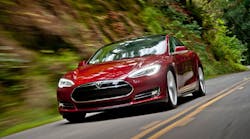A recent media test drive of a Tesla Model S car has sparked a lot of interest in automotive circles.
The ride, taken by the New York Times’ John Broder, took a turn for the worse when the electric car’s battery died and Broder had to call a flatbed truck to deliver him to a charging station.
The point of the trip had been to test Tesla’s new East Coast Supercharger network, which features two fast-charging stations – in Newark, Del. and Milford, Conn. – about 200 miles apart.
By Broder’s account, the test failed, as he had to make a number of sacrifices while driving in order to successfully make the trip, including making unplanned stops at other charging stations, reducing speed and lowering the cabin temperature — all in the name of preserving the car’s 85 kilowatt-hour battery.
The story made news not only because of Broder’s disheartening review of Tesla but also because of the response by the automaker’s CEO Elon Musk. Musk charged the Times writer with altering the facts to support an anti-electric car agenda and even produced travel logs to support his claims.
It’s not my place to judge which account was accurate; I’ll leave that to Times’ Public Editor Margaret Sullivan. And, besides, that’s not the story.
Broder’s test drive seems to point to something larger in the green car world: accessibility.
While electric cars certainly eliminate the need for gasoline, they remain limited by infrastructure. While there are 5,375 public electric charging stations in the U.S., according to the Department of Energy, the stations are not nearly as readily available as gas stations, which is to be expected. Some states, like California, have 1,126 stations (or 20% of the country’s charging stations), and others, like Montana, have a single station.
The truth is, there’s still a lot of ground to cover before EVs will become more than a commuter vehicle.
Take Montana for instance. A family driving across the state, with its one charging station, would be hard pressed to make it across the more than 600-mile stretch of the western state. Especially when one considers a vehicle like the Nissan Leaf, the world’s most popular EV, has a range of roughly 100 miles per charge.
Perhaps that’s why Nissan in December announced plans to introduce 15 new hybrid models to the market by 2016. The move by Nissan, which has been touted as the leader in EVs, with its devotion to the Leaf, is a potential indicator that the company’s conviction in the pure EV is wavering.
Gasoline-electric cars recharge internally, eliminating the need for a nationwide network of recharging stations, and, at least partially, address concerns about being environmentally responsible.
However, while the lack of infrastructure is a concern for EVs, it is improving. Musk himself has vowed to open more Supercharger stations.
And as the infrastructure — and popularity — grows, knowledge, too, about EVs also will spread. As Times’ reader Roger Wilson of Falls Church, Va. pointed out in a letter to the paper, many of the problems Broder experienced during his test drive could have been avoided had the writer read the car’s owner’s manual, which directs drivers on the best methods to conserve battery life and increase range.
Drivers have been maneuvering gas-fueled vehicles on roads for so long, it’s going to take some time for EV best practices to infiltrate the masses.




